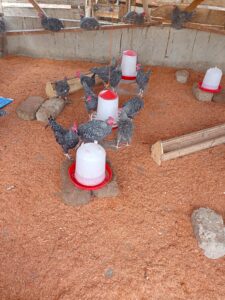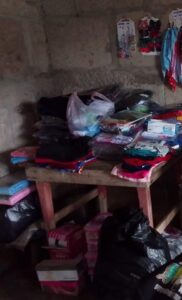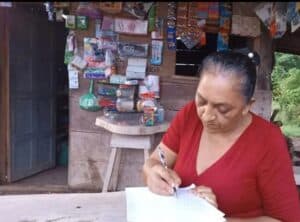
The Community of Boca de Sabalos Can Now Drink Water Straight from the Tap
By Orlando Montiel Salas – Clean Water Program Officer

Installing a chlorinator in Boca de Sábalos.
Boca de Sábalos is the largest community in El Castillo municipality in Rio San Juan, located 48 km (29 mi) from Self-Help International’s training center in Quinta Lidia. Boca de Sábalos is divided by a river going through the town, which splits the town into western and eastern sides. In April 2018, Self-Help’s clean water program and the Boca de Sábalos community were able to install a CTI-8 chlorinator on the eastern side of the river, bringing clean water to 200 households comprising 1,500 people. Two months later, in June 2018, we were able to install a second chlorinator on the western side of the river to treat the drinking water used by the 400 people in the community’s remaining 84 households.
Eugenia has lived in Boca de Sábalos for the past 23 years, ever since she moved with her parents from Chinandega, Nicaragua at the age of 14 years old. She lives and works on the western side of the river, and reflected on the impact of clean water on the communities eight months after installation:
“Life has changed for us in this community. I’m very fortunate to have good quality water now, and this is thanks to the chlorinator that Self-Help International helped us install in our community water tank.

Eugenia serving fresh juice made with clean water.
“I’m a business owner. I have a small grocery store, and that’s how I make money to take care of myself and my family. Because I have clean water, I can sell my drinks – a mixture of natural juice and water – with confidence because the water will not cause health problems for other people. It wasn’t always like this because our water used to be contaminated.
“There are four people in my household including me, so we sometimes use a lot of water. When we used to need water, we had to go collect it from somewhere else. The water was usually dirty and smelly, and we had to boil it before we could drink it.
“At one point, we started receiving water from an aqueduct on the eastern side of the river, but it wasn’t chlorinated either at the time, and it was difficult to set up PVC pipes going across the river to carry the water. Eventually, we stopped receiving water from the eastern side of the river.
“Two years ago, all of us on the western side of the river and the mayor’s office pledged money to build a concrete tank to store the surface water we collected on our side of the river. For a while, we used this water for drinking water.
“That water had problems, too. It wasn’t good, it had sediment in it, and it was a yellowish color. In order for my family and me to be able to drink the water, I used to strain it into plastic bottles and put it out in the sun all day. Because we didn’t have a community chlorination system, many households looked for their own ways to treat the water to make it drinkable. In many cases, people drank straight from the water source without any type of treatment.
“I remember that many people suffered from vomiting and diarrhea. One of my neighbors, Ana, had chronic stomach aches and diarrhea. Ana said she thought her problems were caused by a virus, but I didn’t think it was a virus – I thought it was because of the water. I explained to her that her health problems were caused by the dirty water she was drinking because she did not use any method to purify or treat her water.
“There was another time when some sort of parasite came out of the water. It looked like a worm, and we took it to the health center. After the doctors saw the worm, they told us to boil or chlorinate our water before drinking it. I followed their recommendations for my family and myself.

Boca de Sabalos’ contaminated water sample.
“When Orlando took a sample of my community’s water from the water tank and tested it, the water tested positive for contamination. Vicente, the president of our Water and Sanitation Committee (CAPS), scheduled an emergency community meeting to show us the results.
“The bag with the tested water was black, which is the color it turns during the test if it’s contaminated. I was shocked when I saw it. I got scared and said, ‘This is the water that we’re drinking!’
“In that same community meeting, we decided to collect money to buy a CTI-8 chlorinator and chlorine tablets to treat the drinking water for the western side of Boca de Sábalos. We agreed that the chlorination system would benefit everyone in the community and that it was an important way to maintain our health. Then and there, we all agreed to pay for and maintain a CTI-8 chlorinator so that we could have drinking water safe for human consumption.
“Now, my community can drink the water and feel more confident and secure. The chlorine tablets kill bacteria that contaminate the water, so we don’t end up going to the health center with diarrhea and vomiting and frequently as we used to. The money we spend to maintain the water system and buy the chlorine tablets every month is worth it because we now have safe water in our homes.

Children playing in Boca de Sabalos.
“A month ago, the CAPS leaders held a meeting with the rest of the community to explain the importance of continuing to chlorinate the water, and we all agreed to continue maintaining the water system. When we use the tap water in our homes, we can smell the chlorine in the water and that makes us feel confident to keep drinking our water. Our children in look healthier and happier, and they’re able to go to school and have fun playing because they’re not getting sick from the water.
“I just want to express my honest appreciation to Orlando and Self-Help International for all the assistance you have provided to improve the quality of our drinking water. We feel more assured knowing we have quality water in our community.”
—
World Water Day is March 22, 2019! Help more communities like Boca de Sábalos access clean water by making a gift here!

 Next Post
Next Post


